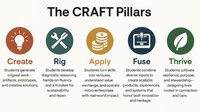It’s so refreshing to find edtech companies thinking about how things are now versus trying to still sell products and services to how it used to be. You know, prehistorically before the pandemic and perhaps for a decade before for trends like the disillusionment with higher ed debt and the “everyone-must-go-to-college” on-size-fits-all culture.
It never fit that everyone, all of humanity, was college bound, and it never happened. That’s not the natural state of humanity. We are all unique. Further, jobs that last 30-50 years are so two generations ago. Now, students may find they retool and reskill multiple times and have wildly divergent careers in totally different fields within their lifetime.
It’s fitting that the tumultuous current Age will give way to what philosophers have spoken about as the “Age of Experience,” where life is curated even on the career front, brands talk incessantly of user-interface and user-experience, and even wardrobes ship to one’s home pre-customized.
Pearson, and their brand Connections Academy, is leading the way in thinking about these issues and has already started delivering what’s needed and wanted by schools and the present generation as it slides ever further in the direction of high demand for both macro- and micro-career skills and certificates.
Nik Osborne, who leads the Pearson Virtual School organization known as Connections Academy, said in a recent interview that their focus is “serving students in K-12 in virtual hybrid learning environments,” but that description did little to explain their true depth. How are they adapting?, was asked.
Osborne acknowledged that what they had been finding as a company, and through research, is that for whatever reason, the traditional brick and mortar school experience doesn’t work for many students.
“Sometimes it's special education needs that a brick and mortar can't provide. And more and more we're seeing, kind of more of an emotional state where students are struggling being in that kind of physical environment. The districts in a lot of cases, they don't have the resources or the support that the student and the family needs [for such flexibility.] And so, traditionally, pre-covid, the large majority of our demographic was made up of students like that. [For example,] we'll get like this amazing athlete that's training for the Olympics, and they need a really flexible schedule so that they can do their training. For the most part, pre-Covid, that was our demographic. Then, obviously during Covid, the world overnight needed virtual learning across the board.
So we have seen obviously a different mix of demographic [in recent years], where we've seen families that are coming that said, okay, well, we were forced into this during Covid and we actually kinda liked it, we liked this flexibility. And we've seen this uptick that has maintained even past Covid, even past the point where brick and mortars kind of went back to school and masks flew off and everything was back to normal. We'll, we're still serving about 40% more students than we did pre-Covid.
Osborne said Pearson went further, though, urged on to create to meet other demographic shifts “through their various offerings, which now include a nascent English Language Learning division to accompany their full end-to-end curriculum offerings and qualifications and assessments divisions.”
They now also have the Workforce Skills Division.
How novel that a company like Pearson, admittedly one of the larger ones operating in the grand edtech ecosystem, is somewhat taking on the mantle of readying the American, even international, workforce – normally the province of companies or higher education with some electives offered in K12 couched in small amounts of time around core instruction.
This new Pearson Workforce Skills Division is more, it is a “both adult learning opportunities, upskilling certifications, improving jobs and opportunities, working directly with companies and with their actual learners to increase those pathways and experiences,” said Osborne.
How did this come about?
Osborne said that “roughly 18 months ago, we started thinking a little bit more about, well, okay, we know how to get a student from fifth to sixth grade. We know how to get a student that's credit deficient, how to catch them back up from a credit perspective so they don't get left behind. We know how to graduate kids we've been graduating them for the past 20 years, but what else? And so we started looking at what our students and the career opportunities that they would have, the markets they were getting ready to go into. And we said, okay, we can do more. Like how are we preparing our students beyond just getting a diploma? How are we preparing our students for the next phase? We started looking at data that suggested that with our demographic of kids, there were only about 30-35% of students that were choosing to go on to a two or a four-year institution to get a degree.
So that left us with, well, what are the other 65 to 70% doing? What opportunities do [we] have for them? And so that really was the impetus behind the career solutions. And the focus really is about how can we provide students with options, right? And it's not about ‘you must go to college’, right? Because we heard that ten years ago that everyone, you don't have a future unless you go to college. We've actually seen more and more of the market change and companies start to change what they're looking at when they look at potential employees. And it's more, a college degree could be the right thing for certain jobs, but in others it could be a certification or a skill, or maybe they need to meet certain or earn certain badges and then the company will say, ‘Hey, that's enough’.”
Osborne also spoke about partnerships with other companies who had career curriculum and that “Pearson did a lot of research on this, and what we came up with was these pathways that we are rolling out to students, and these are really for students at a younger age, call it sixth grade to eighth grade, to start determining what it is they like to do, right? It’s about giving them opportunities and options to, to figure out where their skills and interests are so that once they’ve decided on some of those things, they can make decisions on pathways. We've, we've created a really flexible option for students to go down various pathways that will actually lead to either a job opportunity or a national certification opportunity or an industry certification opportunity.”
Asynchronous but Human
Pearson’s virtual model is an asynchronous one, with the focus really for the student who has the ability to work through the content and courses on their own – but not without check-ins with live teaching. “We have what we call live lessons that students have to interact with a teacher that works with them for the teacher to understand how they’re working through the content or if they’re behind, if they’re ahead,” said Osborne.
The way Osborne described the real adventure of their learning model is that “It’s a little bit more hands-on than just [someone] like a traditional school counselor would be like where they tell you the science and math credits in order to graduate to this career [of interest already.] There’s actually a human being that sits there and works with the student to say, okay, let’s see which, what opportunities you’ve looked at, what other opportunities are out there, and kind of help them through the [mental] process with things like take this course, use this content, watch this video, and then let’s talk again.” All of that is in order to help the student arrive, for themselves, at the self-confirmed point of interest so that it is real.
Pearson maintains a strong teacher pool across all their virtual experiences and helps schools and districts with a menu of options. “It doesn't mean turning on a virtual experience across the board, but it's more these hybrid solutions for your school or that student. You may cover certain parts of a child's education, but through partnership and this matrix we can kind of supplement where you have some gaps,” said Osborne.
Other points made in the interview made by both myself, from Learning Counsel Research and family experience, as well as Osborne, were that the myth of online or virtual learning being less social is finally starting to turn around. Pearson, for example, has activities for eSports and many other “really cool robust clubs and activities,” and even “local flavors” to how virtual schools are run, and has for many years. My own example was my daughter who met with her fellow traveler virtual students while in their Connections Academy for excursions frequently – including the one out to the Jelly Belly candy factory that I was certain I should have gone on myself. For the educational value, not just the jelly beans!
Osborne’s final mention was that they provide “extremely cool interactive-like live lesson experiences for students, a lot of functionality, so students aren’t just going to be turning in assignments and walk away.”
Nice!
Connections Academy by Pearson
Contributed by Pearson:
Pathways in Business, IT and Health were selected because they are associated with high growth, high opportunity industries that have meaningful employment gaps - with market data suggesting that as many as 25-40% of potential employment positions within these industries are unfilled due to shortages of skilled workers. Additionally, these clusters have seen a shift away from legacy degree requirements over the past several years and instead have prioritized employment candidates with relevant career skills, increasing the value proposition of CTE programs in these industries.
Understanding America’s Labor Shortage: The Most Affected Industries, June 2022. https://www.uschamber.com/workforce/understanding-americas-labor-shortage-the-most-impacted-industries 2
The Emerging Degree Reset , The Burning Glass Institute, Feb 2022 https://www.burningglassinstitute.org/research/the-emerging-degree-reset
***











